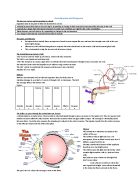-
Peripheral nervous system: consists of a series of nerves which resides or extends outside the central nervous system. The main function is connecting the central nervous system to the limbs and organs. It is divided into two
-
Somatic nervous system: is part of the peripheral nervous system which is associated with the voluntary control of the bodies activities (movement) through action of skeletal muscles and the reception of external stimuli which helps the body keep in touch with its surroundings.
-
Autonomic nervous system: is part of the peripheral nervous system that acts as a control system below the consciousness and controls visceral functions.
Functions of the nervous system:
The nervous system has three main basic functions:
(a) sensory neurons: receive information from the sensory receptors
(b) Interneuron’s: transfer and interpret muscles
(c) Motor Neurons: send appropriate impulses and instructions to the muscles and glands.
The nervous system controls our lives and all our body functions, every action, every response is coordinated by the nervous system all emotional, physical and mental changes. Also internal changes are coordinated by the nervous system.
The structure of the nervous system the nervous tissues are composed of nerve cells and their various processes, together with a supporting tissue called neuroglia, which, however, is found only in the brain and medulla spinalis. Certain long processes of the nerve cells are of special importance, and it is convenient to consider them apart from the cells; they are known as nerve fibers.
Organs and their functions:
Brain: is the center of the nervous system responsible for thinking and making decisions.
Spinal chord: conducts sensorary information for PNS conducts motor information from the brain
Eyes: provides vision
Skin: mechanical barrier for touch
Nose: sense of smell
Ears: responsible for sensing and collecting sound
Tongue: sense of taste
Inner ear: helps maintain balance
Diagram of nervous system:
Test for Receptor Organs:
-







